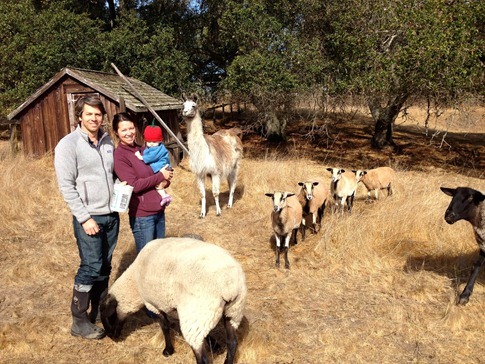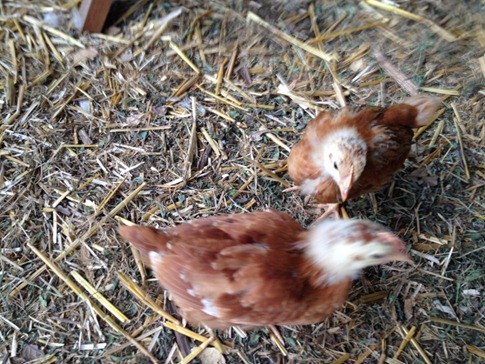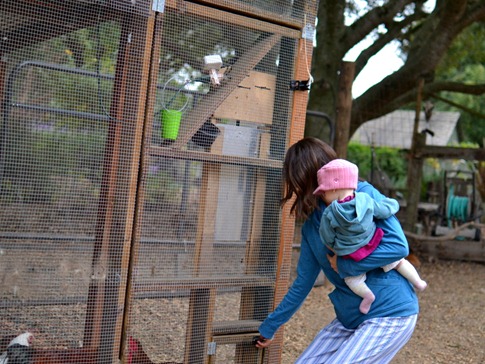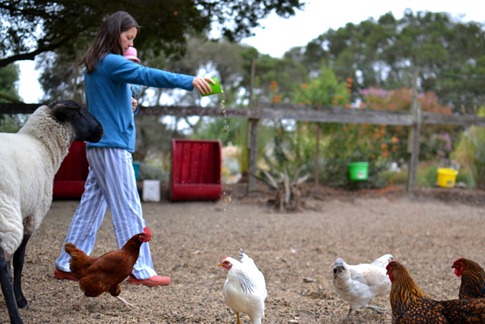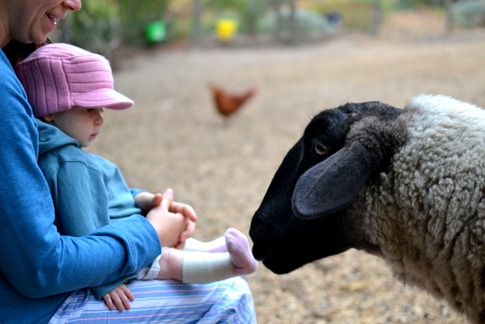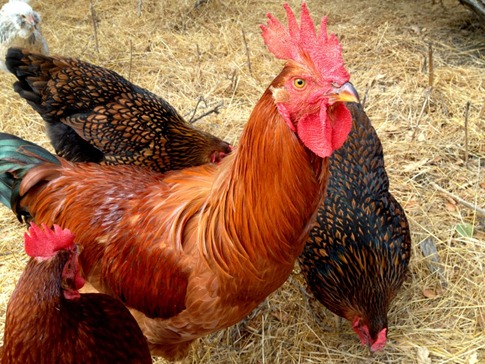If you’ve been following along, you know that our farm has not historically offered chickens the longest lifespan. There was the malfunctioning automatic door incident where we learned that technical solutions are never 100% reliable and then the time someone left the egg door open where we learned that humans are not 100% reliable. Still, we’d prefer not to have to keep our girls locked up all day, albeit in their amply-sized coop and run. Letting them range during the day gives them access to grass and bugs that make their eggs that much better and while they’re pecking and scratching for treats, they’re spreading the sheep manure around the pasture and clearing away leaves piled at the bases of trees or along fencelines. Plus, they just look so happy and add an unquantifiable feeling of “farminess.” And in the worst case, at least the free-range, organic, pastured predator population will be well fed. But, hey, that’s life on the farm.
Five months ago, we drove down to the feed store in town with a cardboard box in the backseat of the car to pick out some new chicks. We’d had nine chickens our first time around, and once they all started laying, would get close to three dozen eggs a week, far more than we could possibly use and close to the limit we could even pass off to friends. So this time, we’d decided to take a more sensible approach and pick up four new chicks to add to our current flock of two, a 2-week-old Ameraucana who our mother hen had hatched (the only survivor of the recent raid) and our seemingly unkillable Rhode Island Red who had thus far survived each of the bloodbaths. As we entered the back room filled with cages for the adolescents and warmers for the chicks, some dark black birds with caramel accents caught our eye. We settled on two of these Golden-Laced Wyandottes, about four weeks old, which would mean we’d get eggs from them in about 3-5 months. For the other two, we decided on some 2-week-old Hampshires (a breed developed from crossing the hardiness of Rhode Island Reds with the egg production of Leghorns) who would be the same age as our Ameraucana.
Whoever laid out the chick room had clearly gone to a retail marketing seminar and figured out to put the adorable little fluff balls right by the exit. Week old chicks are the Dentyne, Altoids and US Weekly of the poultry section. With two more peeping impulse buys (Delawares) playing “Jello” in the cardboard boxes in the backseat of the car, we headed home. Okay, so we now had eight chickens. Still better than nine, right?
In the first few months, the chicks grew quickly, losing any remnants of the light, wispy feathers they were born with to longer, more defined new ones. At that point, they enter an awkward adolescence best compared to that reported by reflective supermodels on late night talk shows; They’re gawky, splotchy, uncoordinated and the older chicks pick on them. It’s not uncommon with pairs of animals of the same type or breed to have what they call a “poor doer.” We started to notice that one of the two Hampshires we’d picked up just didn’t seem to be “doing” as well as the other. We chalked it up to competition for food and figured she’d just catch up a little later.
Then one night, I found myself perusing the forums at Backyard Chickens and came across a section called “What breed or gender is this?” When we’d hatched out our chicks, I’d spent some time Googling how to determine the gender of day old chicks. While there were plenty of techniques discussed like dangling them from their feet or necks (the males are supposed to curl up to peck or scratch while the females give up), most amateurs were excited to report that they could get it right about half the time. I could get those numbers with “eenie meeny miny mo.” The experts at the hatcheries use more advanced techniques like inspecting feather growth or peering into the vents that contain the sexual and elimination organs. Still, the signs on the incubators at the feed store can only promise 90% accuracy. Lessee, if thus far we’d bought 10 chicks (4 the first time and 6 this time) from the feed store, that would mean that the odds are… hmmm… carry the 2… add the remainder… ? Damn, I’m so bad at math. Someone help me out here.
I started composing a post on the forum. Yes, one of our Hampshires was growing much faster than the other. Yes, the larger one had a more pronounced comb and waddle and yes, it had slightly more coloration in its tail feathers. But, as had been explained by the members of the forum in responses to other posts, all that could be explained by different speeds of maturation or slight variations in the breeding. The key, they all concluded, was in the behavior. Did the chicken in question behave like a rooster? I went outside to take some video.
I posted the thread anyway, but after having been charged by the bigger Hampshire every time I pointed the camera in its general direction while the others scattered, there was little doubt in my mind. A few weeks later, we heard the first attempted crow. Pretty sad really, like a teenager whose voice is changing, but he slowly became a man.
For some, that proud call would be a death sentence. Most neighborhoods don’t allow roosters, if they allow chickens at all. But we’re fully immersed in Ag country 5 miles outside of the city limits, not to mention Petaluma’s history as “The Egg Basket of the World.” Heck, our neighbors run an organic chicken farm. We’d happily keep him if only so I could ask everyone who visits if they want to see my co... [EDITED FOR CONTENT BY ANN].
But hey, that’s life on the farm.

